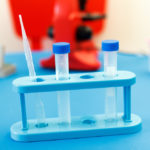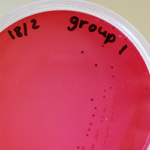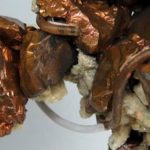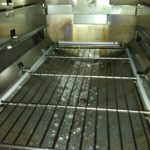Chelsey Kline
Chelsey gained a PhD in Biochemistry and Molecular Biology from Oregon Health and Science University School of Medicine.
Articles by Chelsey Kline
Studying nucleic acid interactions with proteins can be accomplished using a rapid and efficient electrophoretic mobility shift assay (EMSA). This method is essentially an agarose gel electrophoresis technique that detects protein:nucleic acid interactions, as the mobility of the labeled nucleic acid will be retarded if bound to a protein (compared to unbound DNA). A lesser-known…
Making mutations in mammalian cell lines is becoming much easier, especially with advanced molecular engineering techniques such as CRISPR/Cas9, among others. However, after making a mutation, do you know if all of the cells contain the same mutation with the same expression profiles, and are therefore homogenous? If you have 100% transfection efficiency using a…
Fourier transform infrared spectroscopy (FTIR) is an extremely sensitive technique for measuring the absorption and intensity of electromagnetic radiation in the infrared region of the spectrum of either a solid, liquid or gas sample. You can use FTIR to: quantify unknown compounds identify unknown compounds study the detailed structured coordination of compounds How Does Fourier…
Mammalian cell culture techniques are not something you learn from a book, per se. And because of this, it is important to be properly trained, especially in sterile techniques. It is important to keep your cell lines from contamination and just as important to keep yourself safe. Nevertheless, people tend to do things a little…
When you work in a laboratory, preparing samples sets for many different experiments is a large part of the job. Keeping track of your samples can be tedious or even challenging if you don’t already have a good system in place. However, getting this right is a critical part of the experimental process. In this…
Pulling an over-nighter is a common theme for many of my college friends. I, however, like my sleep—particularly between midnight and 7 am. Therefore, I tend not to stay up late to study and avoided jobs that required me to work a night shift. Then, I went to grad school and had to put in…
Working with anaerobic chambers is a unique skill set to have. It is only necessary if you are working with oxygen sensitive compounds. For example, some metallo-proteins require an oxygen free environment to stay in a reduced state, while others are sensitive and even reactive to oxygen. Sometimes working in anaerobic chambers requires a long…
Bubbles isn’t just the name of my favorite cartoon character from Power Puff girls, or just the best activity for a kid to play with, in general. In my adult world, they stand for a whole lot more, but can still cause extreme emotions. At the lab bench, seeing bubbles brings happiness or sadness depending…
Some days are good and things run like clockwork. Then there are those other days – you know the ones – where you mutter to yourself, “Can’t anything go right today?!?!?” Those are the days you are subject to Murphy’s Law. And I am sorry to tell you “no, nothing will go right” those days…
If you are working in a scientific laboratory, it is very important to be aware of the various types of water available, because the purity may not be acceptable for your specific experimental application. In most labs, there are generally two types of water piped in to the sinks: Industrial Water Industrial water is non-potable…
Ever wanted to go to a conference, but don’t know what to expect, which one to go to, or how to even begin to ask your boss to let you attend a conference? Look no further! I have some suggestions on how to choose from the many great scientific conferences out there, how to get…
Have you ever needed to work in a cold room for a long period of time? For example, if you need to dialyze or purify a protein of interest that is temperature sensitive, working in a 4°C cold room might be the only way to accomplish the work. Well, you are in luck. I dislike…
Fourier Transform Infrared spectroscopy (FTIR spectroscopy) is a useful and exquisitely sensitive technique used to identify and quantify unknown compounds, as well as study fine molecular details. However, to obtain a meaningful IR spectrum, it is not only important to prepare the sample correctly but also to learn how to clean the apparatus that houses…
Mammalian cell culture techniques are not simple, and culturing the cells requires a lot of maintenance as well as patience. In addition, doubling times compared to bacterial cells can take days instead of hours, which is most evident when contamination occurs. However, implementing small-scale hollow fiber bioreactors for culturing mammalian cells can save a lot…
If you do cell culture you will inevitably need to count your cells. Counting cells can be tedious, but it is important to do accurately. Your assessed quantity of living cells will affect all your downstream applications. In this article I will not only cover how to manually count your cells and how to do…

















